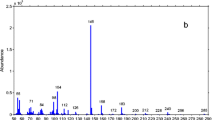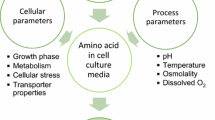Summary
The ability of peptides containing lysine to satisfy the lysine requirement of mammalian cells in a medium otherwise free of this indispensable amino acid was investigated. In contrast to bacteria, which are unable to utilize pentalysine and higher homologs, mammalian cells are able to grow in the presence of di- to decalysine. For each oligopeptide, the response was proportional to concentration within a limited range. The duration of the lag and logarithmic growth phases was directly proportional to peptide size, and the growth rate decreased with peptide size. Utilization of decalysine was not accompanied by the accumulation of smaller oligomers in the medium or in the trichloroacetic acid soluble fraction of a cell lysate. However, enzymes capable of hydrolyzing decalysine were clearly demonstrable inside the cells and in the spent culture medium. It is concluded that the rate of uptake is inversely proportional to peptide size and is growth rate-limiting, and that free lysine produced by intracellular peptidases is used as quickly as it is formed. Although the serum proteins used to supplement the growth medium contained more lysine in peptide linkage than is needed by the cells, this lysine is not available to the cells in significant amount.
Similar content being viewed by others
References
Temin, H. M., R. W. Pierson, Jr., and N. C. Dulak. 1972. The role serum in the control of multiplication of avian and mammalian cells in culture. In: G. H. Rothblat and V. J. Cristofalo (Eds.),Growth, Nutrition and Metabolism of Cells in Culture. Vol. 1. Academic Press, New York, pp. 49–81.
Holter, H., and H. Holtzer. 1959. Pinocytotic uptake of fluorescein-labelled protein by various tissue cells. Exp. Cell Res. 18: 421–423.
Maeir, D. M. 1961. A technique for the study of protein uptake by cells in tissue culture. Exp. Cell Res. 23: 200–203
Ryser, H. J. 1963. The measurement of I131-serum albumin uptake by tumor cells in tissue culture. Lab. Invest. 12: 1009–1017.
Tritsch, G. L. 1969. The role of peptides in the control of growth. In: G. L. Tritsch (Ed.),Axenic Mammalian Cell Reactions. Marcel Dekker, New York, pp. 369–388.
Eagle, H., and K. A. Piez. 1960. The utilization of proteins by cultured human cells. J. Biol. Chem. 235: 1095–1097.
Kihara, H., and E. E. Snell. 1960. Peptides and bacterial growth. VIII. The nature of strepogenin. J. Biol. Chem. 235: 1409–1414.
Merrifield, R. B. 1958. Competitive inhibition of a strepogenin active peptide by related peptides. J. Biol. Chem. 232: 43–54.
Payne, J. W., and C. Gilvarg 1971. Peptide transport. Adv. Enzymol. 35: 187–244.
Merrifield, R. B. 1970. Solid phase peptide synthesis. Adv. Enzymol. 32: 221–298.
Grahl-Nielsen, O., and G. L. Tritsch 1969. Synthesis of oligomericl-lysine peptides by the solid phase method. Biochemistry 8: 187–192.
Tritsch, G. L., J. A. Bell, and G. Grall-Nielsen. 1967. The optimum protein concentration for growth stimulation of axenic cultures of malignant mammalian cells. Exp. Cell Res. 48: 244–247.
Moore, S., and W. H. Stein. 1954. A modified ninhydrin reagent for the photometric determination of amino acids and related compounds. J. Biol. Chem. 211: 907–913.
Oyama, V. I., and H. Eagle. 1965. Measurement of cell growth in tissue culture with a phenol reagent. Proc. Exp. Biol. Med. 91: 305–307.
Richardson, T., J. Hodgett, A., Linner, and M. A. Stahmann. 1959. Action of polylysine on some ascites tumors in mice. Proc. Soc. Exp. Biol. Med. 101: 382–386
Mehrishi, J. N. 1969. Effect of lysine polypeptides on the surface charge of normal and cancer cells. Eur. J. Cancer 5: 427–435.
Piez, K. A., V. I. Oyama, L. Levintow, and H. Eagle. 1960. Proteolysis in stored serum and its possible significance in cell culture. Nature (Lond.) 188: 59–60.
Harper, A. E., N. J. Benevenga, and R. M. Wohlhuetter. 1970. Effect of ingestion of disproportionate amounts of amino acids. Physiol. Rev. 50: 428–558.
Pickart, L., and M. M. Thaler. 1973. Tripeptide in human serum which prolongs survival of normal liver cells and stimulates growth in neoplastic liver. Nature New Biol. 243: 85–87.
Spackman, D. H. 1963. Accelerated system for the automatic analysis of amino acids. Fed. Proc. 22: 244.
Author information
Authors and Affiliations
Additional information
This work was supported in part by a grant (RR-262) from the General Clinical Research Center Program of the Division of Research Resources, National Institutes of Health.
Rights and permissions
About this article
Cite this article
Grahl-Nielsen, O., Ødegaard, P. & Tritsch, G.L. Oligopeptides as sources of indispensable amino acids for mammalian cells in culture. In Vitro 9, 414–420 (1974). https://doi.org/10.1007/BF02615993
Issue Date:
DOI: https://doi.org/10.1007/BF02615993




